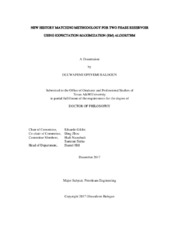New History Matching Methodology for Two Phase Reservoir Using Expectation-Maximization (EM) Algorithm
Abstract
The Expectation-Maximization (EM) Algorithm is a well-known method for estimating maximum likelihood and can be used to find missing numbers in an array. The EM Algorithm has been used extensively in Electrical and Electronics Engineering as well as in the Biometrics industries for image processing but very little use of the EM Algorithm has been seen in the Oil and Gas industry, especially for History Matching. History matching is a non-unique matching of oil rate, water rate, gas rate and bottom hole pressure data of a producing well (known as Producer) as well as the bottom hole pressure and liquid injection of an injecting well (known as Injector) by adjusting reservoir parameters such as permeability, porosity, Corey exponents, compressibility factor, and other pertinent reservoir parameters. EM Algorithm is a statistical method that guarantees convergence and is particularly useful when the likelihood function is a member of the exponential family. On the other hand, EM algorithm can be slow to converge, and may converge to a local optimum of the observed data log likelihood function, depending on the starting values.
In this research, our objective is to develop an algorithm that can be used to successfully match the historical production data given sparse field data. Our approach will be to update the permeability multiplier, thereby updating the permeability of each unobserved grid cell that contributes to the production at one or more producing wells. The EM algorithm will be utilized to optimize the permeability multiplier of each contributing unobserved grid cell.
Citation
Balogun, Oluwafemi Opeyemi (2017). New History Matching Methodology for Two Phase Reservoir Using Expectation-Maximization (EM) Algorithm. Doctoral dissertation, Texas A & M University. Available electronically from https : / /hdl .handle .net /1969 .1 /173215.


